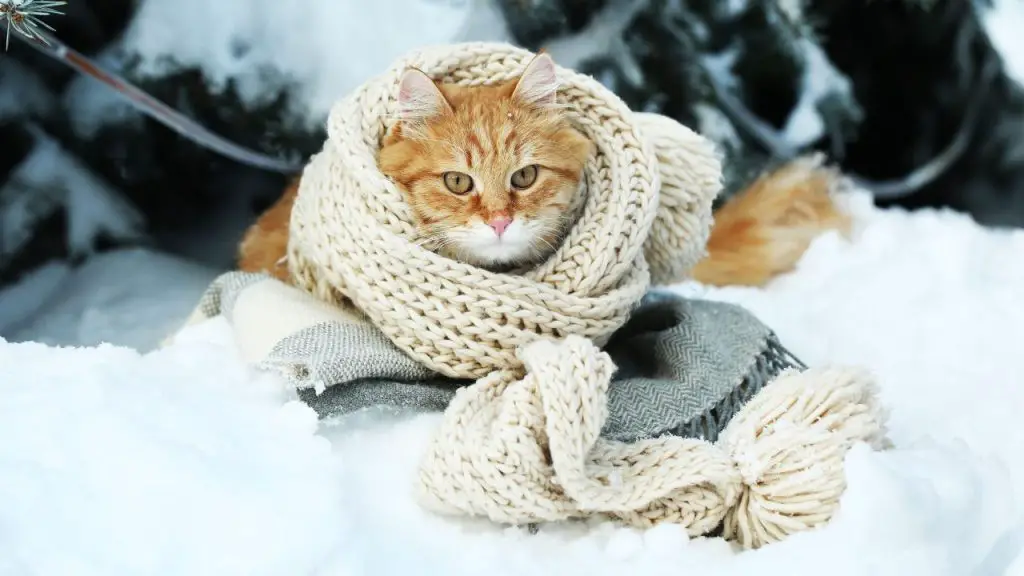Cats can survive in cold weather for varying durations, which is dependent on several factors, including age, health, coat thickness, temperature, and humidity levels. Despite being adapted to cold climates, cats can only tolerate low temperatures for short periods.
Ever ponder how much cold weather your adored cat can take? Cats are well-equipped to survive harsh temperatures – but for how long? In this piece, we’ll discover the answer. Plus, learn how to give your cat a cozy winter! From their fur coats to their whiskers, you’ll get tips on keeping your kitty warm and safe.
Cats love snuggling up in cozy spots. But how cold can they get? When it’s cold, they need extra protection. A cat’s fur absorbs heat, keeping them warm and helping its body temperature stay normal.
So, how long can cats survive in cold weather? Knowing this can help you keep your cat safe during winter.
Key Takeaways
- Cats’ survival in cold weather depends on various factors, including age, health, coat thickness, temperature, and humidity levels.
- Cats are adapted to cold climates and can endure relatively low temperatures for brief periods.
Understanding Hypothermia in Cats
Cats are hardy animals, but their fur and fat reserves can’t keep them warm forever. Hypothermia is a real danger, so understanding it is important. When exposed to cold, cats lose body heat more quickly than they can generate it. This causes their body temperature to drop below normal, leading to hypothermia. If it gets too low, death can occur. Owners should recognize the signs of this condition quickly to prevent serious damage.
Signs of hypothermia include:
- Shivering/trembling
- Lethargy
- Weak/slow heartbeat
- Shallow breathing
- Lack of coordination
- Disorientation/dazed
- Pupilless eyes
- Pale gums
- Low body temp (under 96°F/35°C)
To help counteract hypothermia, use warm water bottles wrapped in towels on the cat’s chest. Additionally, blankets/towels can be used if available – make sure there is room for movement without restricting airflow too much. Seek assistance from a vet if needed – time is vital in severe cases. Every step taken toward recovery counts!
Factors that Affect a Cat’s Ability to Survive in the Cold
A cat’s ability to withstand cold weather depends on many things. Coat type, age, size, body condition, and access to warmth all matter. Long fur and an undercoat keep cats warm. Smaller cats generate less heat. If they lack a thick coat, give them a warm place to sleep or an insulated shelter.
Older cats and sick cats struggle in the cold. Even healthy adult cats may not be able to manage extreme conditions, like windchill in a winter storm. The amount of time a cat can survive in cold temperatures varies. It’s best to keep cats inside when winter arrives.
Signs of Hypothermia in Cats
Cats can suffer from hypothermia in cold weather due to their low body fat. To keep cats safe outdoors, watch for signs and provide a warm shelter.
Signs of hypothermia include:
- shivering or stillness
- slow breathing
- weakness
- gray skin
- a low body temperature (below 95°F)
If your cat shows any of these signs, take them to the vet quickly. If their temperature has already dropped below 95°F, be very careful – it can lead to organ failure or death.
Prevention Techniques to Keep Your Cat Safe in the Cold
To keep your cat safe in cold weather, watch for signs of hypothermia. These include shivering, lethargy, weakness, and loss of appetite. If you spot any of these, get veterinary help quickly.
Stop hypothermia by keeping cats indoors when temperatures drop below freezing. If they must be outside, give them an enclosed area with no drafts. Provide extra food for cold months. Outdoor cats need a shelter like a shed or a garage.
Take your furry friend outside for walks on cold days. Bundle them up with a sweater or jacket. Get pet-safe rain boots to protect yourself from snow and ice. With these tips, you and your pet will stay warm and safe!
Tips for Keeping Your Cat Safe in the Cold
When it’s cold, cats need special protection. Here are some tips to keep your cat safe in cold weather:
- Find warm spots: Search for places in your home that stay warm. Make sure your cat can get to them. You could add a pet bed or blankets near heat sources.
- Limit outdoor time: Your cat should not be outside for too long in winter. This will reduce their risk of hypothermia, frostbite, and other health problems.
- Be aware of dangers: Keep an eye on your cat if there is snow or extreme cold. Snow can block access to shelters and food. It can be deadly. Also, check paws if they get wet. Roads with salt may burn sensitive paws.
- Extra steps: If the weather is colder than usual, take extra steps. Let your cat sleep inside at night. Add extra blankets or a heating pad near sleeping areas. Also, set up a laser pointer game indoors.
What to Do if Your Cat is Exposed to the Cold?
Extreme temperatures can be dangerous for cats, especially if they’re left outside. If your cat is exposed to cold temps, there are steps you can take to make sure they’re safe and comfortable.
- Bring outdoor cats inside as soon as temps drop. This will protect them from predators and car accidents.
- Get shoes or boots for cats who need to stay outside for a long period. The padding will protect their delicate paws from the cold and ice.
If your cat’s already been out in the cold, it’s important to warm them up. Look for signs of hypothermia such as shallow breathing and lethargy, and a body temp below 100°F (37°C). If you think they have hypothermia, move them inside, wrap them in a warm towel, and put them near a source of heat like a radiator.
Be aware that cats can get frostbite if they’re in cold temps for too long. Signs of frostbite include pale skin with redness underneath, swelling, numbness, and pain when touched. If you suspect frostbite, see a vet.
Overall, limit your cat’s time outdoors during extreme weather – both hot and cold – for their safety!
Conclusion
Cats can survive cold temps, but they are not well-equipped. Keep your cat warm! Give them a safe place. Check for hypothermia and frostbite if they’ve been outdoors. Make sure they have good nutrition and access to plenty of water. Taking these precautions will help keep your cat healthy and safe.







